Recently, I had an experience a challenge I wasn’t sure I could finish, yet one that left me feeling elated, exhausted, and proud. This is the story of my first climb up Slieve Donard, the tallest mountain in Northern Ireland, rising 850 metres above sea level and standing above the seaside town of Newcastle, County Down.
Setting Off: Into the Forest Before Sunrise
As we drove into Newcastle in the early hours, the silhouette of Slieve Donard loomed ahead like a sleeping giant. I was nervous and excited — this was my very first attempt at climbing this iconic peak. Thankfully, I wasn’t alone. My sister Kate, a seasoned Donard climber (this would be her sixth time), and her husband Nigel, who was making his 26th ascent, were with me. I felt safe in good hands – and they knew the way!
We parked in Donard Car Park, laced up our boots, and set off before sunrise, heading into Donard Forest. The path was dim, the sky was beginning to turn red with the first glimpse of the sun rising, and the amazing sound of the dawn chorus from the birds in the trees. That and the sound of the Glen River rushing past beside us, all was good. As we climbed steadily, we soon emerged out of the forest and on to the Glen River Trail.
What to Wear for a Mountain Hike
Before we go much further, let me say this—wear the right clothing. Slieve Donard might look welcoming from the base, but the weather can change quickly as you ascend. As the author Alfred Wainwright says, “There’s no such thing as bad weather, only unsuitable clothing”.
Make sure you’re wearing plenty of layers – ideally fast drying base layers, an insulating mid-layer, and a waterproof outer layer. Even if the sun is shining in Newcastle, you could face wind, mist, or even hail higher up. Sturdy walking boots are the best thing for your feet, and don’t forget a hat, gloves, and a backpack with snacks, water, and a rain cover. Being properly kitted out makes the whole experience safer and far more enjoyable.
Sunrise Over Newcastle and Dundrum Bay
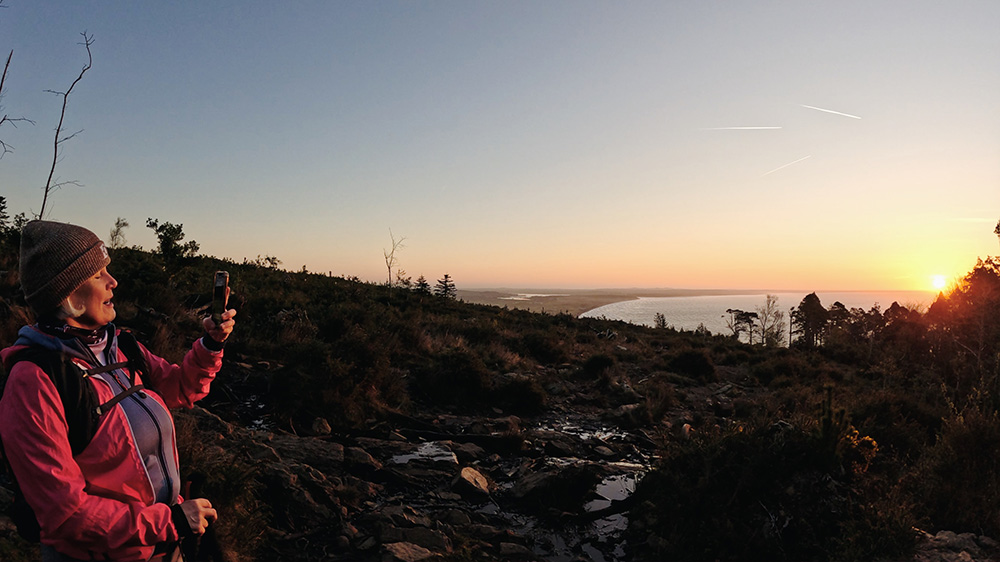
So now, back to the hike. As we emerged from the trees into the clearing, there it was – the sun rising over the horizon, casting golden light across the Irish Sea. We paused to appreciate the wonderful view. Nigel pointed across the water, “That’s Scotland, just on the horizon.”
We were walking the Glen River Trail, the most popular and well-trodden path to the summit. It weaves up through the trees, alongside the river, with waterfalls and ancient stone, and eventually climbs through the granite boulders into the high Mournes.
Stories in the Stone
Along the way, Nigel, ever the storyteller and mountain expert, shared tales and insights about the trail. We passed drainage channels built from granite to protect the path. It is amazing to think of the amount of work that has gone into preserving these trails.
Nigel was a volunteer with the Mourne Mountain Rescue Team for many years, and he has many rescue stories to tell. He pointed out a spot in the woods. “We did a rescue here once,” he said. “A man slipped while holding a coffee and a camera. He had no hands free to break the fall – he broke his collarbone and hurt his leg. We had to stretcher him down from here.”
It was a sobering reminder: this mountain, for all its beauty, demands respect.
Above the Trees, Into the Mourne Magic


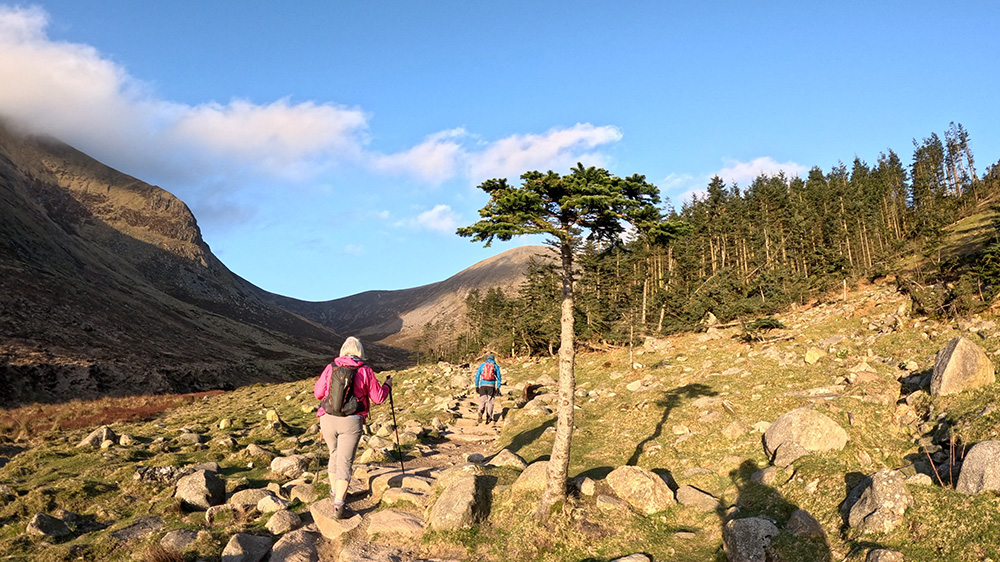
We stopped to study a map of the trail on the side of the path. Nigel explained the contour lines, the saddle ahead, and the final steep ascent to the summit known as the Great Cairn. I mentally prepared myself for the challenge and suggested I might stop at the saddle. “You’ll leave your bag at the saddle,” Nigel grinned, “and we’ll drag you up the rest, if needs be!”
Hidden Histories: Ice Houses, Everest Training and WWII Crashes

One of the most fascinating stops was the Ice House — a small stone structure nestled near the Black Stairs. This was once used to store ice cut by hand from the frozen river or cliffs during bitter winters. The servants would cut the ice and store it in the icehouse where they also stored food and then they would carry the food they needed down to the Lodge. The Lodge is no longer there but once stood near Donard Car Park.
Nigel also explained that famous mountaineer Dawson Stelfox used to train for the Himalayas right here, at the Black Stairs when conditions were icy enough like they were for example in 2010/2011. Dawson Stelfox is the first man from Northern Ireland to have reached the summit of Everest back in 1993.
Just ahead is the site of a World War II plane crash. The scars remain in the form of two bald patches where nothing grows — the soil contaminated by leaked fuel. Nature never fully healed the damage. These haunting reminders of history made us pause in thought.
The Granny Trap and the Healing Trees
We passed through a peculiar little dip in the path known – unofficially – as the Granny Trap. It’s not on any maps, it’s just known as this locally. Maybe it’s called this because if you fall in you may never get out again! Tread carefully!
Nearby, Nigel pointed out trees with bubbles of sap. He explained how this kind of sap was used by Native American tribes as an antiseptic. Slieve Donard isn’t just a climb; it’s a natural history museum, a healing space, and a living storybook.
Wildlife Encounters and Unlikely Visitors

At the river, we paused to watch a heron looking for fish. I didn’t think herons would have been this far up the mountain but apparently the herons in the Glen River are primarily fishing for brown trout, sea trout and even salmon, which are known to inhabit this river.
Further up the trail, we were greeted by the horses – these horses are not indigenous to the Mournes. They were once domesticated horses that have been abandoned on the hills. They are not native to Slieve Donard but they live on the mountain now and were grazing calmly on the hillside. Another interesting aspect to the hike.
This mountain holds something for everyone — history, wildlife and beautiful views.
The Saddle: Where Doubt Creeps In
As we climbed, the views expanded. Looking back, I could see how far we’d come – and yet, looking up, it felt like we had so much still to go. The saddle, that flat section between peaks, remained just out of reach but getting closer to it.
The climb steepened. “This isn’t funny anymore,” I gasped, legs burning. Kate surged ahead. I wasn’t sure I could make it. “This might be my end point,” I said aloud. But Nigel was having none of it. “We’re not done yet,” he said. “Just keep moving.”
And so I did. One step at a time.
The Mourne Wall and Final Push

As we neared the top, we were back in the sunshine. The Mourne Wall came into view – a mighty dry-stone wall snaking over the mountain tops for 22 miles. It was built over 100 years ago as part of a job creation scheme during an economic depression, and to enclose the water catchment area, protecting reservoirs from contamination from sheep and cattle on the hills.
To think of the men who hauled stone up here and built that wall, by hand, in all weather – it gave me a new perspective on effort, perseverance, and pride in hard work.
The Final 270 Metres
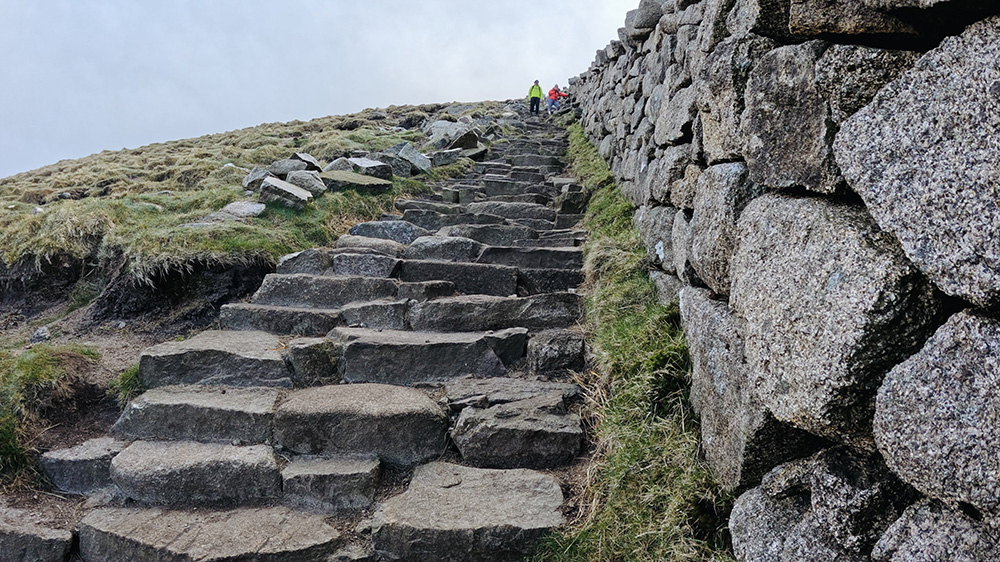
The last 270 metres to the summit were hard going. It was really steep and with my fear of heights and no sight of the horizon, I was really fearful and tearful! I didn’t care that hikers were going up and down past me. I just wanted to go back down before reaching the summit! But, Nigel to the rescue. He came down to where I was and took my bag and I inched my way up the last 270 meters. The slope eased, and I found myself at the top! It was an amazing feeling, but I would not have made it without Nigel and Kate.
At the summit of Slieve Donard, standing beside the Great Cairn.
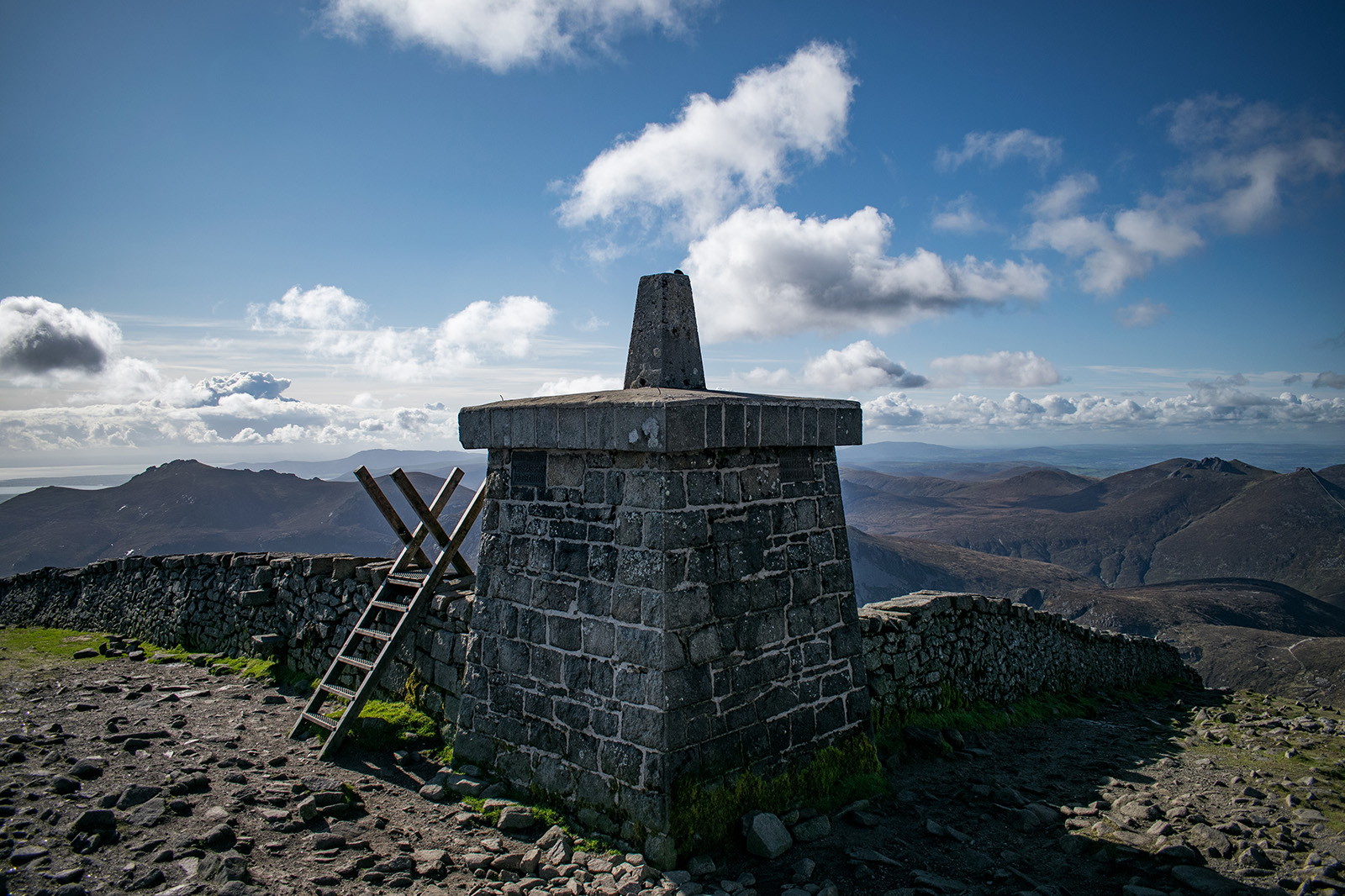
The world stretched out in all directions – sea, land, sky. But the cloud was down, and we couldn’t see a thing! No matter, I was just so delighted to have achieved this, I didn’t care. I had already got lots of lovely footage at the saddle with the drone and the whole way up from Donard Forest. It would have been great to capture the views from the summit, but that will have to wait until the next time! Here is what it looks like! (photo by others)
Reflection: More Than a Climb
It took us four hours to reach the top — and even more hours to get down again, as my aching legs inched along the pathway down. But I had done it. I had climbed Slieve Donard.
I was thrilled!
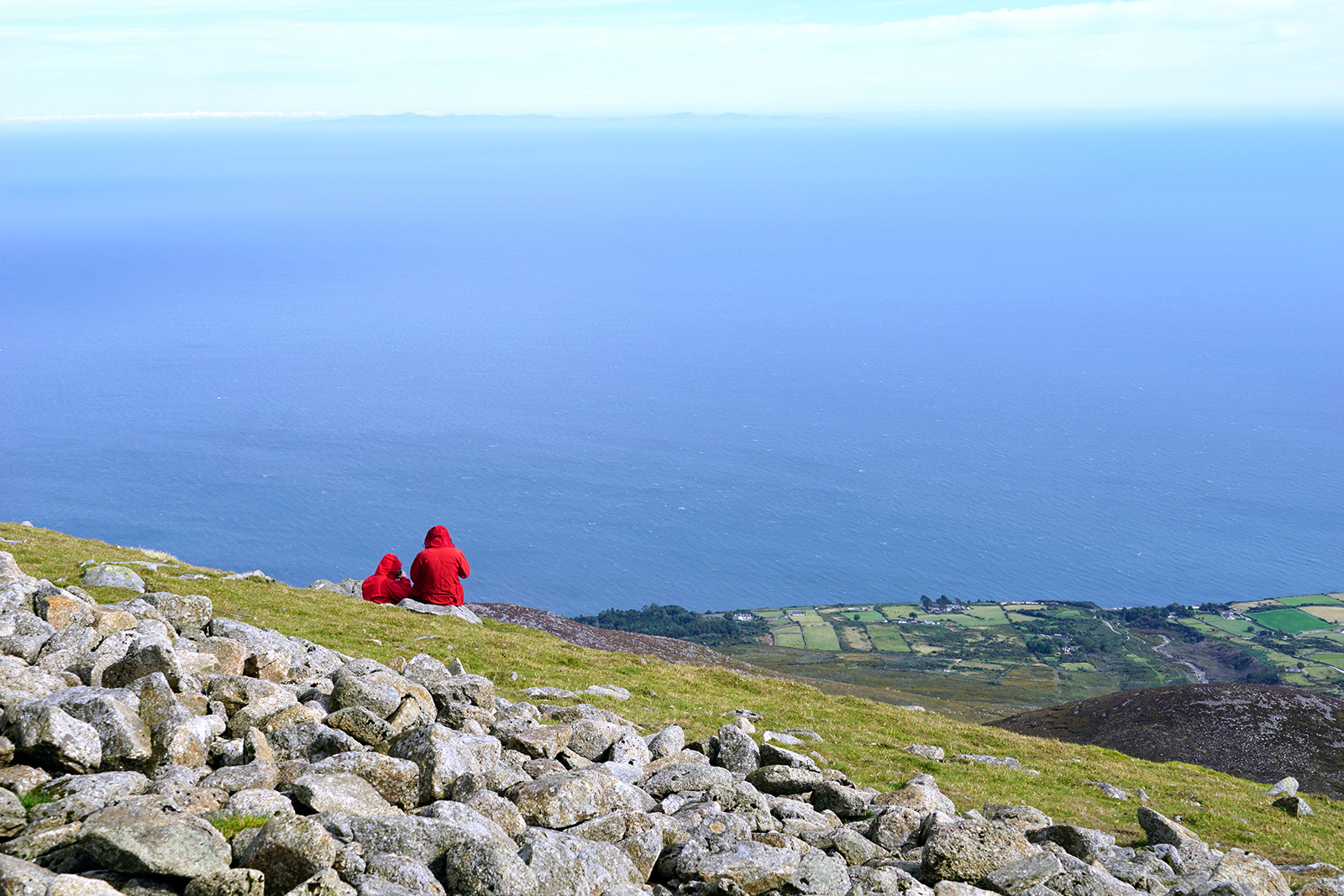
It wasn’t just the view, though it was breathtaking. It wasn’t even the achievement, though I’m incredibly proud. It was the reminder that with good people beside you, and the courage to keep moving – you can do hard things. You can push past your limits and find a great deal of satisfaction on the other side. I’m very grateful to Kate and Nigel for their constant encouragement. And I’m in awe of my nephew Jack Proctor, who ran up and down the entire mountain in one hour and one minute. When you’ve climbed Donard the hard way, you appreciate just how amazing that is.
Final Thoughts

If you’re considering climbing Slieve Donard – do it. Prepare well, go with someone who knows the mountain, and take your time. You’ll encounter beauty, history, wildlife, and probably a few aches and pains. But most of all, you’ll find a great sense of achievement.
Thanks for reading, and thanks again to Nigel for all his stories and knowledge — you truly are a mine of information.

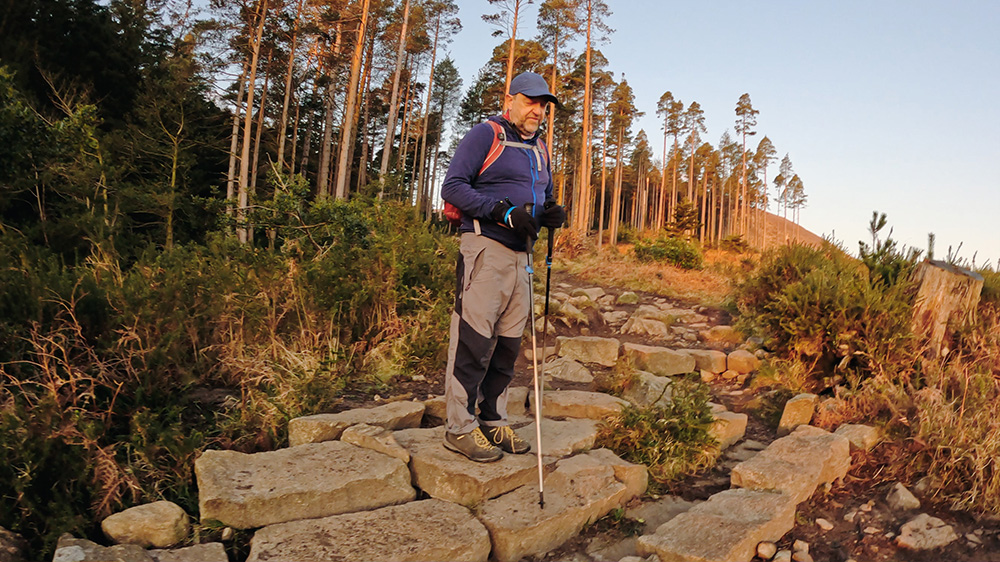
If you enjoyed this blog post and want to see the video from our climb, it is at the top of this blog post. Be sure to check out Avante Video on social media. Hit like, share with a friend, and join us on the next adventure.